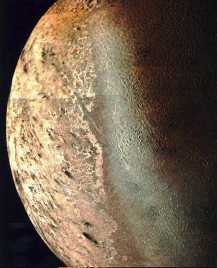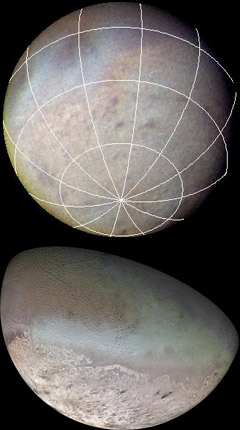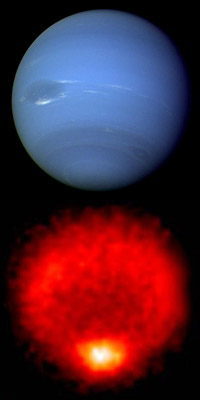This is an image of Triton.
Click on image for full size
NASA
Triton
Triton was discovered by W. Lassell in 1846. Of the 8 moons, it is the 2nd farthest from Neptune, with a standoff distance of 354,800 km.
Triton may be one of the largest of the icy moons, is comparable to Europa, with a diameter of 2700 km (1800 miles). 1800 miles is about half the distance across the United States.
Triton is very interesting, it has a unique and fascinating surface, and is one of the few moons with the possibility for a weak atmosphere and an environment suitable for life. Triton is also unusual for its retrograde orbit. Because Voyager 2 did not pass very close to Triton, it was not determined whether Triton is composed completely of ice, or is a rocky moon with an icy surface.
You might also be interested in:

How did life evolve on Earth? The answer to this question can help us understand our past and prepare for our future. Although evolution provides credible and reliable answers, polls show that many people turn away from science, seeking other explanations with which they are more comfortable.
...more
This beautiful image of Triton reveals many interesting features of its surface. The surface of Triton is halfway between Ganymede's and Europa's (two of Jupiter's moons). Ancient portions of the surface
...more
Triton is most like Jupiter's moon Europa. Like Europa, the interior of Triton may have been warm enough at one time to contain a liquid layer just under the surface. On Earth, we know that there are some
...more
When the Voyager mission flew by Triton, it took the spectra of the surface. The spectra matched that of ice and also several different kinds of snow (crushed ice). The Voyager spacecraft could not measure
...more
Triton is the largest moon of Neptune. It is a very unusual moon. The poles of Triton are especially interesting. Triton has a polar ice cap at the South Pole. Earth, of course, has ice caps at its poles
...more
Observations taken by the Hubble telescope show that Neptune's largest moon, Triton, has heated up since 1989. That means global warming isn't something that just happens on Earth. This increase in temperature
...more
Neptune has // Call the moon count function defined in the document head print_moon_count('neptune'); moons. It also has rings, but its rings are different from Saturn's. Neptune's largest moon is named
...more
The South Pole of the planet Neptune is a bit strange. Triton, Neptune's largest moon, also has interesting features at its poles. Neptune is tilted on its axis by about 28°. That isn't so strange... Earth
...more










